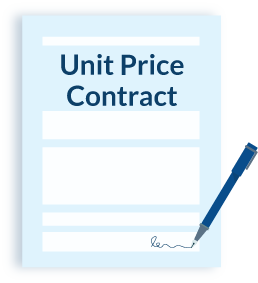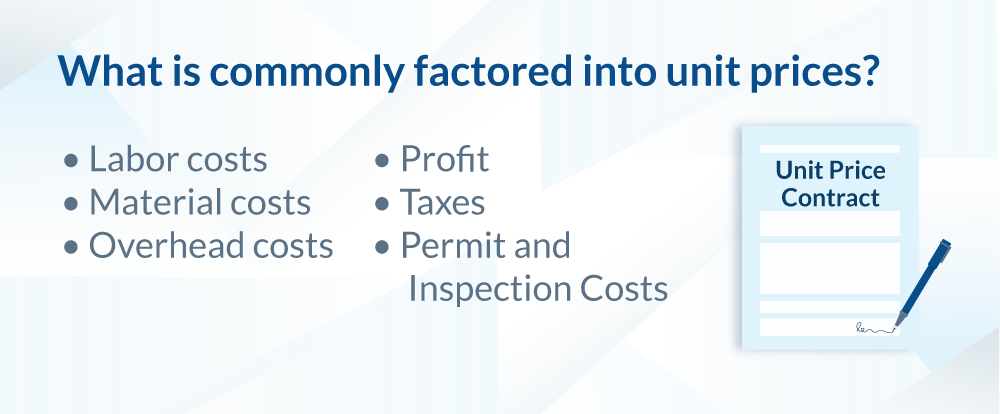
A construction project is a collection of complex processes. That means contracting for construction can be just as complex. One of the many ways that construction contracts may vary is the method used to determine the price for the work. One of the more common methods is to use a Unit Price Contract. Read on for a thorough explanation of how a Unit Price Contract is used in construction.
What Is a Unit Price Contract?

In a unit price contract, the total contract price is based upon the price of all the individual “chunks” — or units — of the work. Under a unit price contract, the contractor provides the owner with a specific price for one or more tasks or a partial “segment” or a “block” of the overall work that’s required on the project. The owner then agrees to pay the contractor for the units that the contractor expends to complete the project.
So, rather than taking a look at the project as a whole and setting a price based on that finished product, a unit price contract will determine the price based on the “units” that will be required to make up that job. Often, the number of units needed won’t really be specified at the start of work.
Unit Price Contract Example
The simplest example of a unit price contract is probably paying for dirt by the load. You might not know exactly how many loads will be necessary, so picking one overall price at the start might not make much sense.
However, determining a fair price for each load isn’t all that difficult. Unit price contracts are used for many other projects, trades, and tasks, but still – it’s a good way to wrap your head around the concept.
What Is a “Unit” in a Unit Price Contract?
A “unit” represents a block of work, materials, or a combination of the two that will be provided. It may take any number of units to complete the entire job – and usually, there will be some estimate as to how many units will be required at the start of the job.
Throughout the life of the project, it’s important to track and reassess that original estimate, however. This is called “measuring” and “remeasuring,” and unit price contracts are often referred to as measurement contracts, measure and pay contracts, or remeasurement contracts for this very reason.
What Costs Go Into Pricing a Unit?

This is the fun part! Any cost that will go into completing that unit of work can go into the price. This includes not only material costs but also, other less obvious ones.
Here’s a list of costs that are commonly factored into unit prices:
- Labor costs
- Material costs
- Overhead costs
- Profit
- Taxes
- Permit and Inspection Costs
Taking it back to the dirt hauling example can help provide some clarity here. In order to run a profit, haulers need to understand their costs that are associated with each load. That way, they’ll know what the break-even point is and how low they can go on prices while still maintaining an acceptable profit margin.
So, a lot of variables that are present on construction projects are baked right into a unit price contract. If more work is needed to complete a job than was originally estimated, the contractor’s or supplier’s profit margin (%) should stay the same — the extra work will be factored into the price as more units.
If more materials are needed – that’s fine! It’s right there in the cost of the unit. Conversely, if less work is needed, the percentage of profit will remain the same for the contractor, but the overall cost will be less than in the original estimate.
Learn how an Escalation Clause can protect the bottom line:
Construction Contracts: What Is an Escalation Clause?
When Should You Use a Unit Price Contract?
A unit price contract makes a lot of sense when work can easily be divided into identifiable chunks (units). So, where projects are repetitive or the price is heavily dependent on materials, and where the ultimate quantity of work might not be obvious from the get-go, using a unit price contract makes a lot of sense.
On the other hand, complex projects that involve blending activities between different trades or materials may not be ideal to use with unit price contracts. While a unit price contract may not be ideal for an entire project, it may still be a great tool for both contractors and owners to use for those portions of a project which can be easily quantified.
Unit price contracts are most commonly used for public construction projects. However, it could make a lot of sense for certain trades to utilize unit price contracts on private jobs, too.
Unit Price Contracts Can Make Invoicing Easier
By using a unit price contract, owners can easily verify the price that contractors charge for goods and services. Similarly, contractors can easily keep an eye on their cost of goods and variable costs associated with a particular project.
We’ve discussed remeasurement a few times now, but it’s worth noting that because unit pricing contracts have costs that are so thoroughly broken down, it’s easy for an owner to compare an invoice with the anticipated price of project units. Unlike some other types of contracts where contractor markup is a behind the scenes operation, units are pretty transparent. That means an owner can always be sure they’re being charged fairly and according to their contract.
On the other side of the coin, when you have a unit price contract with your customer, it’s pretty easy to invoice them. The price per unit should be determined well in advance to the actual performance of the work so it might be as simple as easy multiplication. Plus, when unit prices are predetermined, it’s easy to avoid arguments with the customer over what costs are included in an invoice.
Learn about other types of construction contracts
- Cost-plus contracts
- Time & materials contracts
- Lump-sum contracts
- Guaranteed maximum price contracts (GMP)

